






Lingua Franca IV
Lingua Franca IV, is in the Burguert's collection at the Akademie de Kurnste in Berlin, Germany. 2017
The text belongs to the famous Argentine historian, Ruth Corcuera, from the book:
Weavers of the quichua forests.
"Thousands of years ago, when only the voice recorded small and big events of every day
life, women would cover their newborn child in a wrap. In this we see a space created
between the mother's womb and the world outside. We believe textiles were born from
such gestures, within the realm of feelings and from a women's view: to protect, to give
warmth and to sustain livfe. In time, textile art will be the means to tell us through colours
and designs that the world can be read through symbols, as in a written text. In the great
American cultures these symbols were a kind of lingua franca and textiles a major art with
many roles, among them to express that where words did not suffice"
76 x 50 cm
Watercolor and walnut ink on Rives BFK paper
Year: 2017
Lingua Franca IV
76 x 50 cm
Year: 2017
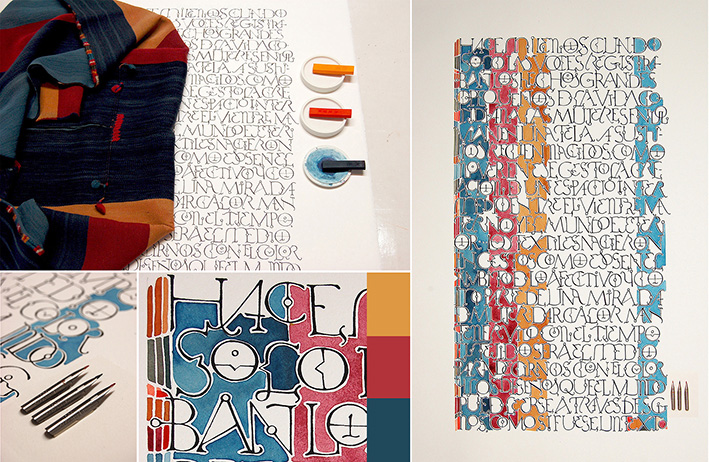
Lingua Franca III
Lingua Franca III, is in a private collection in San Francisco, USA. 2015
The text belongs to the famous Argentine historian, Ruth Corcuera, from the book:
Weavers of the quichua forests.
"Thousands of years ago, when only the voice recorded small and big events of every day
life, women would cover their newborn child in a wrap. In this we see a space created
between the mother's womb and the world outside. We believe textiles were born from
such gestures, within the realm of feelings and from a women's view: to protect, to give
warmth and to sustain livfe. In time, textile art will be the means to tell us through colours
and designs that the world can be read through symbols, as in a written text. In the great
American cultures these symbols were a kind of lingua franca and textiles a major art with
many roles, among them to express that where words did not suffice"
76 x 50 cm
Watercolor and walnut ink on Rives BFK paper
Year: 2015
Lingua Franca III
76 x 50 cm
Year: 2015
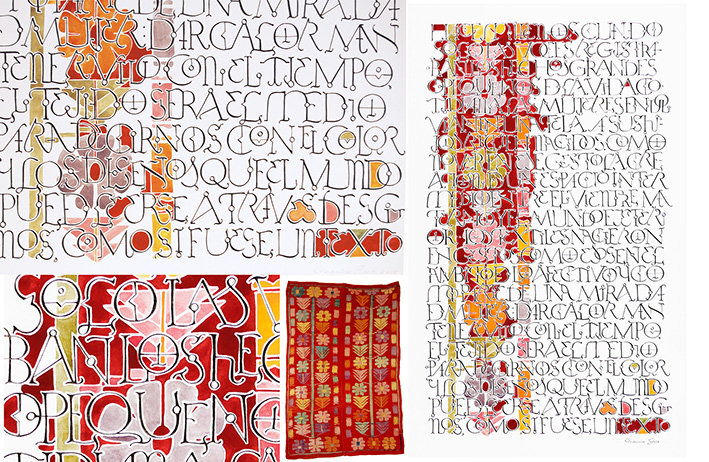
Lingua Franca II
Lingua Franca II, depict it's colors from an antique textil (early XX centuary). 2014
The text belongs to the famous Argentine historian, Ruth Corcuera, from the book:
Weavers of the quichua forests.
"Thousands of years ago, when only the voice recorded small and big events of every day
life, women would cover their newborn child in a wrap. In this we see a space created
between the mother's womb and the world outside. We believe textiles were born from
such gestures, within the realm of feelings and from a women's view: to protect, to give
warmth and to sustain livfe. In time, textile art will be the means to tell us through colours
and designs that the world can be read through symbols, as in a written text. In the great
American cultures these symbols were a kind of lingua franca and textiles a major art with
many roles, among them to express that where words did not suffice"
76 x 50 cm
Watercolor and walnut ink on Rives BFK paper
Year: 2014
Lingua Franca II
76 x 50 cm
Year: 2014
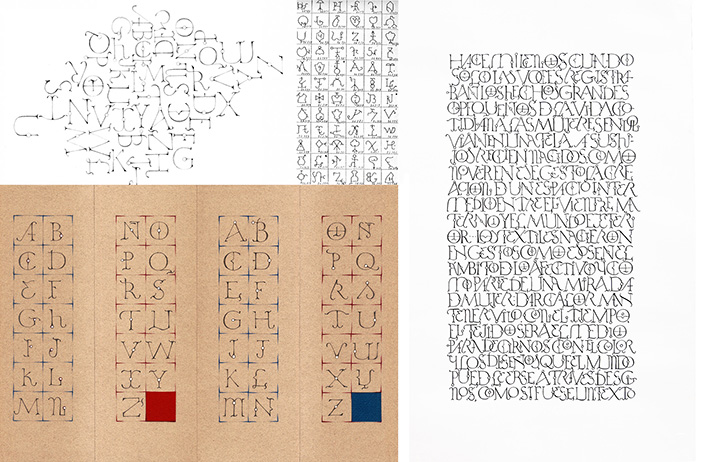
Lingua Franca I
Lingua Franca I, Shows the development of the "gaucho”alphabet inspired on cattle brands of the province of Buenos Aires, Argentina. 2013
The text belongs to the famous Argentine historian, Ruth Corcuera, from the book:
Weavers of the quichua forests.
"Thousands of years ago, when only the voice recorded small and big events of every day
life, women would cover their newborn child in a wrap. In this we see a space created
between the mother's womb and the world outside. We believe textiles were born from
such gestures, within the realm of feelings and from a women's view: to protect, to give
warmth and to sustain livfe. In time, textile art will be the means to tell us through colours
and designs that the world can be read through symbols, as in a written text. In the great
American cultures these symbols were a kind of lingua franca and textiles a major art with
many roles, among them to express that where words did not suffice"
76 x 50 cm
Watercolor and walnut ink on Rives BFK paper
Year: 2013
Lingua Franca I
76 x 50 cm
Year: 2013
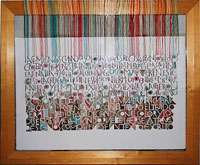
Graphic textile
The text belongs to the famous textile artist Ruth Corcuera from the book: "Weavers of the quichua forests".
“Thousands of years ago, when only the voice recorded small and big events of every day life, women would cover their newborn child in a wrap. In this we see a space created between the mother�s womb and the world outside. We believe textiles were born from such gestures, within the realm of feelings and from a women�s view: to protect, to give warmth and to sustain livfe. In time, textile art will be the means to tell us through colours and designs that the world can be read through symbols, as in a written text. In the great American cultures these symbols were a kind of lingua franca and textiles a major art with many roles, among them to express that where words did not suffice. ”
This artwork will be exhibited in the National Textile Art Showin the Palais de Glace, Buenos Aires, Argentina.
53 x 65 cm.
Watercolour and walnut ink on Rives BFK paper. Embroiding threads wrap a wooden mark.
Year: 2010
Graphic textile
53 x 65 cm.
Year: 2010

Weaving dreams I
"A story is unfold, and from it, thousands of pieces florish.
Some of them are truly works of art. Save them!
Preserve them with love because with love they were weaved.
In the future they will become part of some other fabric.
Keep on weaving and do not ask about them.
There will come a time to unfold them.
Just for today, do not think, weave, weave, weave.
Weave like crazy, weave with tears,
Weave with laughter, weave while screaming,
Weave with anger, weave with euphoria.
Weave words and good dreams.
Do not get discouraged� keep on weaving
Somewhere you will find the pattern.
Text by Marina Soria
30 x 90 cm.
Watercolours and walnut ink on Magnani Bianca paper. Embroiding threads, on wooden frame.
Year: 2010
Weaving dreams I
30 x 90 cm.
Year: 2010

Weaving dreams
"A story is unfold, and from it, thousands of pieces florish.
Some of them are truly works of art. Save them!
Preserve them with love because with love they were weaved.
In the future they will become part of some other fabric.
Keep on weaving and do not ask about them.
There will come a time to unfold them.
Just for today, do not think, weave, weave, weave.
Weave like crazy, weave with tears,
Weave with laughter, weave while screaming,
Weave with anger, weave with euphoria.
Weave words and good dreams.
Do not get discouraged� keep on weaving
Somewhere you will find the pattern.
Text by Marina Soria
20 x 70 cm.
Watercolours and walnut ink on Magnani Bianca paper. Embroiding threads, on wooden frame.
Year: 2010
Weaving
dreams
20 x 70 cm.
Year: 2010

Thousand of years ago I
The text belongs to the famous textile artist Ruth Corcuera from the book: Weavers of the quichua forests.
“Thousands of years ago, when only the voice recorded small and big events of every day life, women would cover their newborn child in a wrap. In this we see a space created between the mother´s womb and the world outside. We believe textiles were born from such gestures, within the realm of feelings and from a women´s view: to protect, to give warmth and to sustain livfe. In time, textile art will be the means to tell us through colours and designs that the world can be read through symbols, as in a written text. In the great American cultures these symbols were a kind of lingua franca and textiles a major art with many roles, among them to express that where words did not suffice.”
30 x 90 cm.
Watercolours and walnut ink on Magnani Bianca paper. Embroiding threads, on wooden frame.
Year: 2010
Thousand of years
ago I
30 x 90 cm.
Year: 2010
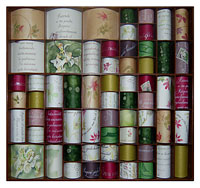
Minimum gestures
"She recalled her dad.
Took a deep breath,
exhaling the air very slowly
Till her lungs were empty.
That minimum inherited gesture
brought her back to serenity
and recovered her from the hustle and bustle,
Renewing her energies."
Text by Marina Soria
45 x 41 cm.
Watercolours and walnut ink on varios types of papers within a box.
Year: 2010
Minimum gestures
45 x 41 cm.
Year: 2010

Embroidery gestures
"She recalled her dad.
Took a deep breath,
exhaling the air very slowly
Till her lungs were empty.
That minimum inherited gesture
brought her back to serenity
and recovered her from the hustle and bustle,
Renewing her energies."
Text by Marina Soria
52 x 27.5 cm.
Watercolours and walnut ink on Ingres paper. Wooden box and embroiding threads.
Year: 2010
Embroidery gestures
52 x 27.5 cm.
Year: 2010
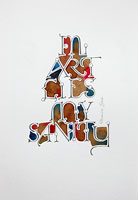
Sanity
Original text in english:
“In art lies my sanity!”
Sandra R. Wagner
24 x 30 cm.
Watercolours , walnut ink and pencil on Arches paper.
Year: 2010
Sanity
24 x 30 cm.
Year: 2010

Abu’s memories I
My grandmother used to tell me this tale about a poor street boy's destiny who didn't want to go to school.
Read Full Text56 x 76 cm.
Acrylic, walnut ink, sumie and gouaches on Strathmore and Arches paper. Gold and bronze leaves.
Year: 2001
Abu’s memories I
56 x 76 cm.
Year: 2001

Abu’s memories II
My grandmother used to tell me this tale about a poor street boy's destiny who didn't want to go to school.
Read Full Text50 x 70 cm.
Gouache, Walnut Ink, board and photo on Shoeler paper.
Year: 2001
Abu’s memories II
50 x 70 cm.
Year: 2001
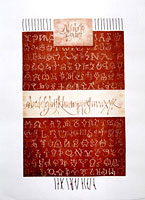
Bovine Alphabet
50 x 70 cm.
Gouache, acrylic, walnut ink, strings and beads on Arches paper.
Year: 2002
Bovine Alphabet
50 x 70 cm.
Year: 2002

Andean Blanket
“In recent paintings...the idea of emptiness is of special importance... . There is no doubt that art and poetry, not only contemporary, but of all times, reach their highest points when they achieve to penetrate magically... in that pattern of the plane and the emptiness from which all is made and which shows us the sense of nature”
Text by Anthony Tapies from the Dier Brucke's Gallery Catalogue, 1989.
58 x 58 cm.
Gouache, walnut ink on Arches paper. Folded, masking fluid.
Year: 2002
Andean Blanket
58 x 58 cm.
Year: 2002

Martín Fierro II
The pictures I'm going to paint will last
For men not born to scan,
I don't need any to show me how,
Or change my drawing, then or now,
The man doesn't paint who would like to paint,
But the man, I guess, that can
Private collection.
57 x 76 cm.
Gesso, sand and gouache on Lanaquarelle paper, folded pen and brushes.
Year: 2002
Martín Fierro II
57 x 76 cm.
Year: 2002

Nocturno II
Glass freshens when you lean your forehead on the window. (...)
Read Full Text
50 x 70 cm.
Gouache and inks on Canson Mi Tientes paper
Year: 1998
Nocturno II
50 x 70 cm.
Year: 1998

Usos del poncho
Usos del Poncho, art and tradition. Alberto G. Bellucci. Head of Decorative Art Museum.
Read Full Text
Private collection.
90 x 131 cm.
Gesso, acrylic, gouache, walnut ink, strings, beans and brick on fabric all built up on a paper screen.
Year: 2003
Usos del poncho
90 x 131 cm.
Year: 2003

Ronda de un Cuitrufe
“Let's go to the party, said the priest.
It's in a rancho, said the carancho. (...)”
Read Full Text
57 x 76 cm.
Gouache on Lanaquarelle paper. Folded Pen.
Year: 2002
Ronda de un Cuitrufe
57 x 76 cm.
Year: 2002











